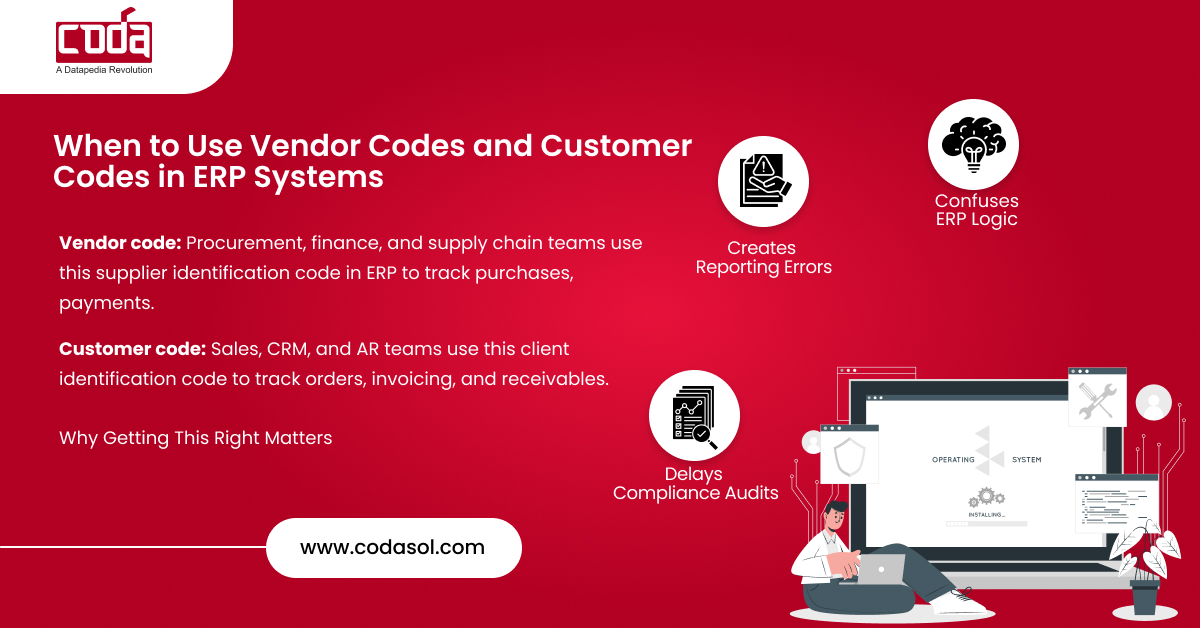If you’re spending too much time fixing data mismatches or tracking down purchase errors, the problem may be simpler than you think: you’re using vendor codes and customer codes interchangeably. That’s like using the same ID for both your supplier and buyer. In theory, it might seem efficient. In reality? It causes chaos.
Let’s fix that. This guide clears the fog around Vendor Codes vs. Customer Codes in ERP, helping you reduce errors, cut costs, and make better decisions fast.
Quick Answer: What’s the Difference?
| ERP Code Type | Used For | Who Uses It | Key Function |
|---|---|---|---|
| Vendor Code | Supplier Identification | Procurement, Finance, Supply Chain | To track purchases, payments |
| Customer Code | Client Identification | Sales, CRM, AR teams | To track orders, invoicing, receivables |
Simple rule:
- Use vendor codes for anyone you pay.
- Use customer codes for anyone who pays you.
Why Getting This Right Matters
Using the wrong codes or blending them:
- Confuses ERP logic: ERP systems like SAP or Oracle rely on structured data mapping. Mixing codes can crash automated workflows.
- Creates reporting errors: Imagine your CFO pulling a sales report, only to find vendors listed as customers. It distorts your financials.
- Delays compliance audits: Especially in regulated industries like Oil & Gas, Defense, or Healthcare, code misalignment can lead to non-compliance.
Case study
A major steel manufacturer in Saudi Arabia was struggling with overstock and delayed supplier payments. Root cause? The ERP system had 15 suppliers wrongly tagged under customer codes. Procurement workflows triggered customer invoices instead of vendor POs.
Fixing the coding structure improved:
- PO processing time by 38%
- Payment cycle accuracy by 51%
- Supplier trust and delivery timelines
When to Use Vendor Codes
Use vendor codes when:
- You’re managing purchase orders (POs)
- Tracking supplier performance
- Handling incoming goods
- Logging vendor invoices and payments
Example:
In a construction EPC firm, each subcontractor (steel, MEP, concrete) should have a unique vendor code for efficient cost tracking across projects.
When to Use Customer Codes
Use customer codes when:
- You’re managing sales orders (SOs)
- Tracking client purchase history
- Processing accounts receivable (AR)
- Automating CRM or marketing workflows
Example:
In marine & ports operations, each shipowner or logistics company who books cargo space or terminal services needs a customer code to streamline billing and SLA tracking.
Can One Entity Have Both Codes?
Yes, but only in rare cases.
For example, a logistics partner in India may supply fuel to your fleet (vendor) and hire your cranes (customer). You’ll need two separate codes in the ERP, one in the vendor master and one in the customer master.
Never merge them. Doing so will cause double-counting or worse, system conflicts.
Common Code Structuring Methods
Implementing a standardized code structure is crucial for maintaining data integrity and ensuring seamless ERP operations.
Sample Code Formats:
| Code Type | Format Example | Description |
|---|---|---|
| Vendor Code | VND-IN-000123 | Vendor in India, Serial #123 |
| Customer Code | CST-GCC-QTR-0005 | Customer in GCC, Qatar, ID 0005 |
| Hybrid Code | SUP-SAUDI-LOG-099 | Logistics supplier in Saudi Arabia |
Best Practices:
- Use prefixes to denote entity type (e.g., VND for vendors, CST for customers).
- Incorporate geographic identifiers for regional clarity.
- Maintain a consistent length and format for all codes.
Still wasting hours sorting vendor data?
Talk to our ERP experts. We’ll walk you through a free 30-minute audit and help you take control of your vendor master once and for all.

ERP Code Optimization Checklist
Regularly auditing your ERP codes can prevent data anomalies and enhance system performance.
Optimization Questions:
- Are all codes unique and free from duplication?
- Is there a standardized format applied across all codes?
- Are obsolete codes identified and deactivated promptly?
- Is there a governance policy overseeing code creation and modification?
- Are codes integrated seamlessly with other systems (e.g., CRM, SCM)?
Mistakes to Avoid
- Using email addresses or names as codes
→ Not scalable. Use system-generated unique IDs. - Creating duplicate entries
→ Causes reconciliation nightmares. Use de-duplication tools. - Not linking codes to correct business units or plants
→ Especially in large enterprises in the GCC or India, code misuse across multiple plants creates discrepancies in stock and spending. - No validation process
→ Introduce a maker-checker system in your ERP code governance process.
Code Governance Roles & Responsibilities
Assigning clear roles ensures accountability in code management:
| Role | Responsibility |
|---|---|
| Data Steward | Oversee code creation and maintenance. |
| IT Administrator | Ensure system compliance and integration. |
| Compliance Officer | Monitor adherence to regulatory standards. |
| Business Analyst | Analyze code usage for process improvements. |
Industry Applications
Here’s how different industries benefit by correctly using vendor and customer codes:
| Industry | Impact |
|---|---|
| Oil & Gas | Supplier SLAs, equipment rental tracking, compliance auditing |
| Utilities | Vendor contract validation, grid asset procurement |
| Manufacturing | Raw material sourcing, just-in-time inventory |
| Real Estate & Construction | Subcontractor management, client progress payments |
| Marine & Ports | Shipping partner billing, fuel suppliers |
| Healthcare & Lifesciences | Medical equipment vendor traceability |
| Banking | Customer KYC tracking, vendor IT services |
| Minerals & Metals | Ore suppliers, customer smelter contracts |
| Government & Defense | Defense contractors, civil project invoices |
| EPC | Multi-vendor coordination, milestone billing |
| Aviation | Aircraft part vendors, passenger service providers |
Frequently Asked Questions (FAQ)
Q1: Can a vendor turn into a customer in ERP?
Yes, but you should always create a separate customer code to maintain clarity in transactions and reporting.
Q2: How often should vendor/customer codes be reviewed?
At least once a quarter—especially for large organizations with frequent onboarding or business model changes.
Q3: What’s the best way to prevent duplicate codes?
Use automated de-duplication tools and define strict naming conventions and code generation rules.
Q4: What if I have international vendors/customers?
Include a country identifier in the code structure to avoid conflicts across regions like the GCC, Far East, or the US.
Q5: Which ERP systems support separate coding?
All major platforms—SAP, Oracle, Maximo, Dynamics 365, Infor—support separate coding for vendors and customers, and even allow for custom workflows to validate data inputs.
Conclusion
In the world of ERP, small errors often create big problems. Understanding when to use vendor codes vs. customer codes in ERP can save your team hours of rework, reduce audit flags, and ultimately improve the trustworthiness of your enterprise data.
By creating a clear distinction in your master data strategy, especially across India, the GCC, Far East, and US markets, you’re not just fixing codes, you’re laying the foundation for intelligent, data-driven operations.

Let our ERP experts give it a health check. No strings attached.

